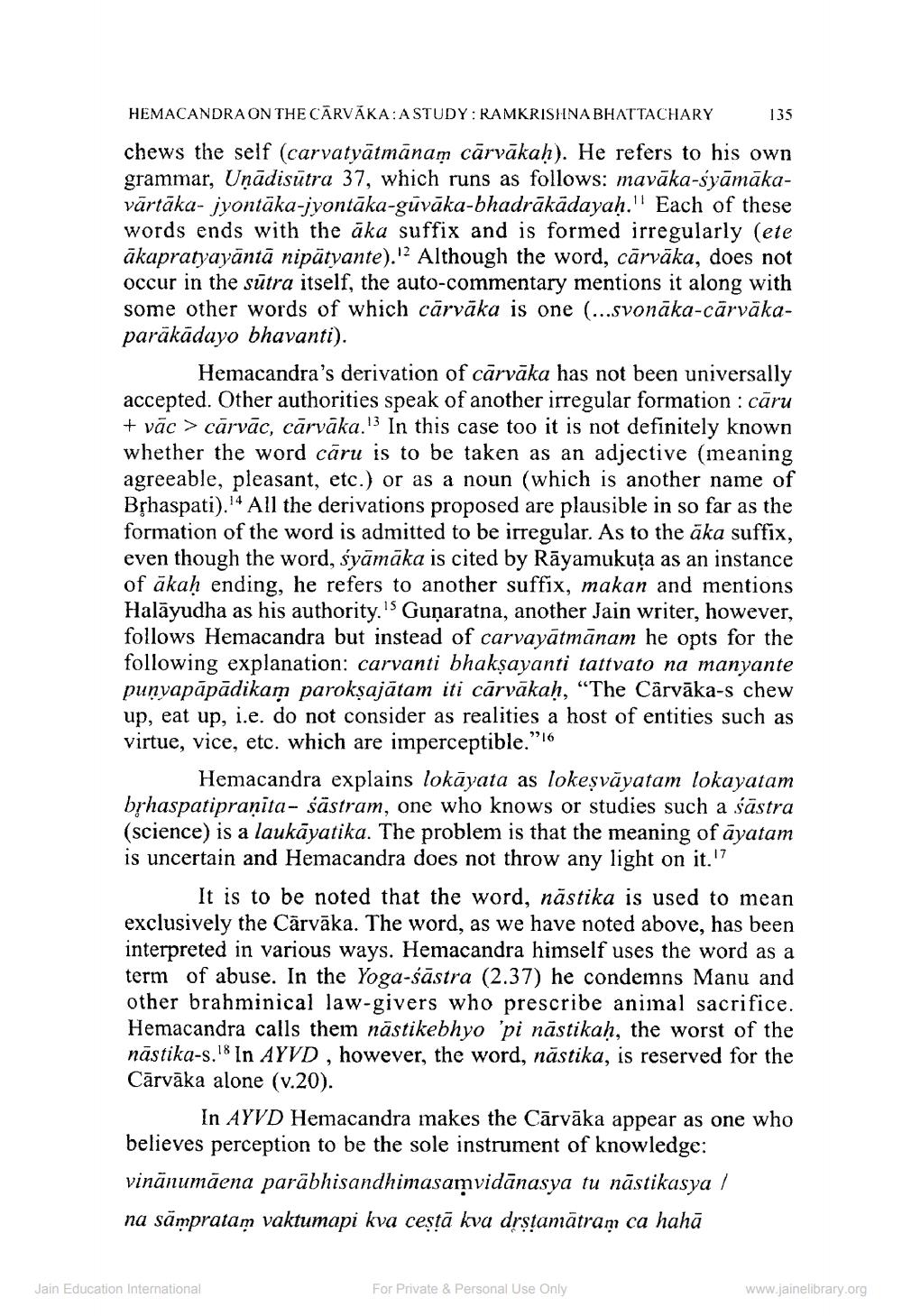Book Title: Jain Journal 2003 01 Author(s): Jain Bhawan Publication Publisher: Jain Bhawan Publication View full book textPage 8
________________ HEMACANDRA ON THE CĀRVĀKA:A STUDY: RAMKRISHNA BHATTACHARY 135 chews the self (carvatyātmānam cārvākah). He refers to his own grammar, Unādisutra 37, which runs as follows: mavāka-syāmākavārtāka- jvontāka-jyontāka-guvāka-bhadrākādayah." Each of these words ends with the āka suffix and is formed irregularly (ete ākapratyayāntā nipātyante).'? Although the word, cārvāka, does not occur in the sūtra itself, the auto-commentary mentions it along with some other words of which cārvāka is one (...svonāka-cārvākaparākādayo bhavanti). Hemacandra's derivation of cārvāka has not been universally accepted. Other authorities speak of another irregular formation : cāru + vāc > cārvāc, cārvāka.13 In this case too it is not definitely known whether the word cāru is to be taken as an adjective (meaning agreeable, pleasant, etc.) or as a noun (which is another name of Bșhaspati).4 All the derivations proposed are plausible in so far as the formation of the word is admitted to be irregular. As to the äka suffix, even though the word, syāmāka is cited by Rāyamukuta as an instance of ākaḥ ending, he refers to another suffix, makan and mentions Halāyudha as his authority.'s Gunaratna, another Jain writer, however, follows Hemacandra but instead of carvayātmānam he opts for the following explanation: carvanti bhakşayanti tattvato na manyante punyapāpādikam paroksajātam iti cārvākaḥ, “The Cårvāka-s chew up, eat up, i.e. do not consider as realities a host of entities such as virtue, vice, etc. which are imperceptible.”'16 Hemacandra explains lokāyata as lokeşvāyatam lokayatam brhaspatipranita- śāstram, one who knows or studies such a sāstra (science) is a laukāyatika. The problem is that the meaning of āyatam is uncertain and Hemacandra does not throw any light on it." It is to be noted that the word, nāstika is used to mean exclusively the Cārvāka. The word, as we have noted above, has been interpreted in various ways. Hemacandra himself uses the word as a term of abuse. In the Yoga-śāstra (2.37) he condemns Manu and other brahminical law-givers who prescribe animal sacrifice. Hemacandra calls them nästikebhyo 'pi năstikah, the worst of the nāstika-s.18 In AYVD , however, the word, nästika, is reserved for the Cārvāka alone (v.20). In AYVD Hemacandra makes the Cārvāka appear as one who believes perception to be the sole instrument of knowledge: vinānumāena parābhisandhimasamvidānasya tu nāstikasya / na sampratam vaktumapi kva cestā kva drstamātram ca hahā Jain Education International For Private & Personal Use Only www.jainelibrary.orgPage Navigation
1 ... 6 7 8 9 10 11 12 13 14 15 16 17 18 19 20 21 22 23 24 25 26 27 28 29 30 31 32 33 34 35 36 37 38 39 40 41 42 43 44 45 46 47 48 49 50 51 52 53 54 55 56 57 58
